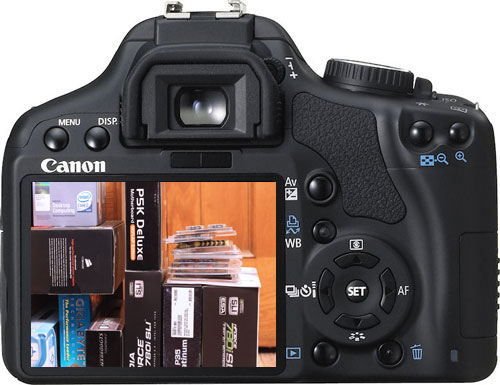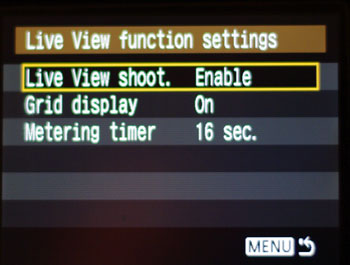Canon XSi: 12.2 Megapixels, Image Stabilized Lens, and Double Live View
by Wesley Fink on May 5, 2008 3:00 AM EST- Posted in
- Digital Camera
Two Live View Modes
When Canon first announced the XSi at the PMA show in late January, they created quite a stir with the announcement that Live View would be available in two modes on the XSi. The first mode was what everyone has been including, namely that the mirror is flipped up and you can see the sensor image on the LCD and manually focus. In this mode Auto Focus requires that the mirror be flipped back down, for AF measurement, which is slow and also momentarily blacks out the Live View.

Mode 2 for Canon Live View uses contrast detection for focusing. The image does not blank on the LCD and focus can happen while you are viewing the LCD. These appear to be the same two Live View modes that are implemented on the $1800 Nikon D300. Unfortunately the contrast detection Live View is still painfully slow on the XSi, meaning that neither mode is very useful for sports or fast moving subjects.

Live View is this year's check box feature and the XSi has one of the best Live View implementations using the main sensor. The only current production camera that uses a different Live View approach is the Sony A350 we recently reviewed. Sony uses a second sensor to provide real-time Live View on the A350 and A300 that is just as fast as using the viewfinder for shooting. The A350 is 14.2MP while the A300 is 10MP, but both feature a flip-down/flip-up LCD for convenient Live View use.
In terms of focusing speed the Sony A350 is clearly a faster and more convenient implementation of Live View. However, the second sensor in the Sony brings its own set of compromises. The Canon XSi provides basically a 100% view of the image on the LCD, where the Sony second sensor only shows about 90%. Sony also offers no image zoom feature for easier focusing, where the Canon XSi allows selection of an area and Live View zooming for more precise focusing.
The contrast in Live View approaches is pretty dramatic between the Sony A350 and the XSi. If you want to use Live View instead of the viewfinder and shoot using the LCD, Sony Live View is better. If you prefer using Live View for studio-type static or macro shooting, the Canon XSi Live View offers more precise framing and more precise control of the final image.
In addition, the much larger and brighter Canon XSi optical viewfinder makes using the viewfinder easier on the XSi compared to the mediocre tunnel-vision finder in the Sony A350. If you plan to shoot mainly using the traditional viewfinder then the Canon XSi is the better choice, with slow but decent Live View shooting options.










56 Comments
View All Comments
meanjean - Wednesday, September 3, 2008 - link
Anyone had trouble with memory cards not recording pictures because of being dislodged from contact points for some reason?thepieces - Saturday, May 10, 2008 - link
Cool review, but the samples are horrible. A little more effort than images from your back yard please :) Half of which are out of focusMidwayman - Friday, May 9, 2008 - link
"Early testing shows the new 18-55mm IS to be a superb lens with performance comparable to top-line Canon lenses."So you're saying the kit lens is up to L quality. Right.
Also that Nvidia test target you are using is really a pretty poor choice. Almost no fine detail. Noise is only have the story when comparing high iso. You also need to look at detail retention. The only thing that could possibly qualify is the TM. Alot of camera that appear to have low noise do it through destroying detail.
I know a couple other folks have mentioned the lighting. You're doing all this in a low light setting. What about outdoors? People take an awful lot of pictures outside. I know you complain about "studio lighting" but since you can't control outside conditions, at least you can bring the light level up to a reasonable level. For under a $100 you can pick up some work lights at home depot and a couple yards of white muslin to make a large softbox. Test shots are test shots and I'd rather see them at more normal exposures. (and then you can stop down to f8 to get max resolution)
m61376 - Friday, May 9, 2008 - link
I have been trying to decide between the D60 and the XSi for several days, reading everything I could find. The two stores I went to were very Nikon biased. This is one of the best comparative articles for a newbie to digital SLR, upgrading from a point and shoot.I appreciate the XSi comparison to the D60 rather than the D80. I think there are many people like me who are reticent to upgrade to the SLR's because of their size and the larger size and weight of the D80 and the like just take it out of consideration.
iamatrix - Friday, May 9, 2008 - link
Looking at samples from the D60 and Rebel, the D60 images at high ISO look better - better contrast, color rendition, and noise handeling. Canon suffers from high ISO chroma noise, which has been noted by dpreview time and time again, Nikon on the other hand has higher luminance noise. Chroma noise is much harder to deal with in the post processing stage and leaves a blotchy 'digital' look to high ISO images whereas the Nikon grain is more film like and easier to deal with using noise reduction software.Deadtrees - Thursday, May 8, 2008 - link
Though many reviewers and users have been complaining about Canon's yellowish WB under tungsten light, it is, in fact, Canon's policy to keep it that way.It's true that there're times when I want the pictures to look yellowish as it captures the mood of the scene such as in Cafe and restaurant. But at the same time, there're times when I want the pictures to look not yellowish at all.
Having said that, I understand where they're coming from and why they decide to keep it that way. However, it'd be much better if Canon, at least, gives two options in that situation: #1 for true to the eye, yellowish WB. #2 for absolute WB.
Sure, I get around with this 'problem' by having 3 slightly different tungten lighted gray card pictures in the memory card and using them accordingly. It pretty much solves the 'problem' but having that option built-in would be just better and eaiser.
I tried to find the link of the interview talking about this issue but failed. It was an interview done by a Japanese camera magazine with the president of Canon camera. If anyone has the link, providing would be more than greatful.
mikett - Wednesday, May 7, 2008 - link
I meant the shutterbox as the external construction is obvious.Wesley Fink - Wednesday, May 7, 2008 - link
Canon rates the 40D shutter for 100,000 actuations. We can not find a published spec for the XSi (450D) shutter, but it is presumably less than 100,000. The XSi shutter is more likely designed for 50,000 acttuations.punchkin - Wednesday, May 7, 2008 - link
You're talking out of your a**. There's no reason for such a claim.Wesley Fink - Thursday, May 8, 2008 - link
Actually there is a reason. As stated we could not find a spec for the rated shutter life of the XSi, but the 40D does have a specified rated life of 100,000. However a few other entry SLRs have a rated shutter life of 50,000 actuations, and we would expect the XSi to be competitive. That is an assumption and not a hard fact.The rated life for the Olympus E-3 is 150,000 shutter actuations and is specified, but many DSLRs do not specify a rated shutter life.